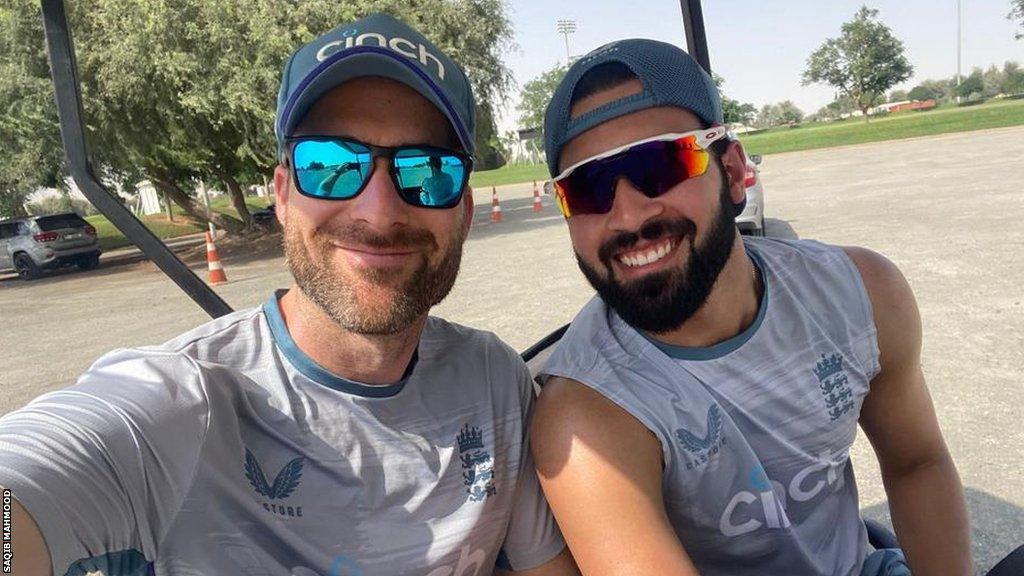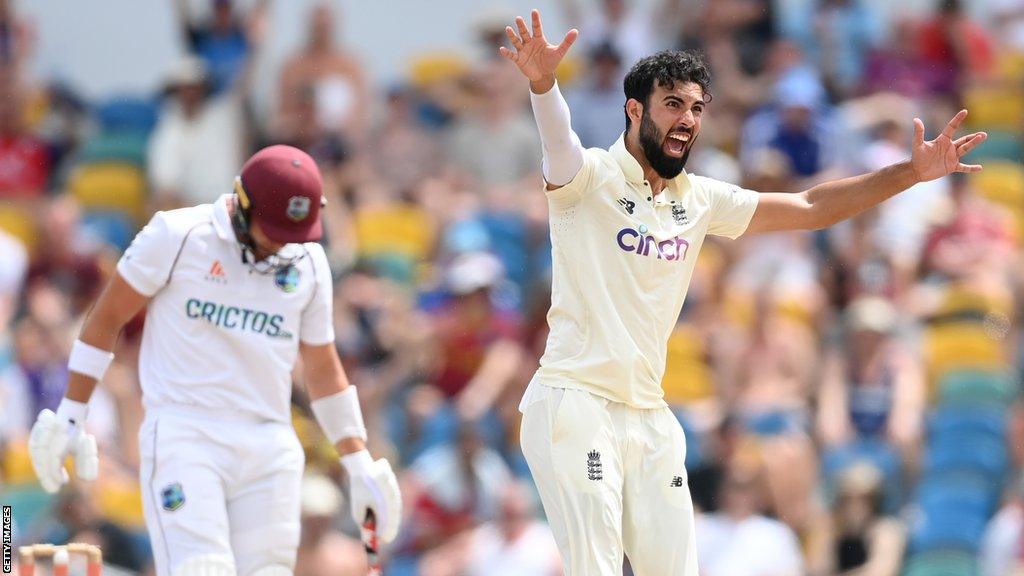Saqib Mahmood: England bowler details stages of recovery from stress fracture
- Published
Saqib Mahmood: England & Lancashire bowler on recovery from back injury
Five months after suffering a stress fracture of the back, Saqib Mahmood finally has a cricket ball in his hand.
It is the last week of September 2022 and Mahmood can bowl again for the first time, albeit without a run-up and with just a bowling coach for company.
"As soon as I got to the middle I was so overwhelmed," he told BBC Sport afterwards. "It looked so far away.
"I visualised my first ball being this little outswinger just outside off stump, the coach taking it in the mitt.
"It did not go that way. It went down the leg side and the coach missed it with a full-length dive.
"It was like I had completely forgotten how to bowl."
Another five, often painstaking, months later and the 26-year-old is making his long-awaited England return in a one-day international in Bangladesh, which got under way at 06:00 GMT.
A journey which started with tears after the phone call which confirmed his diagnosis is now at an end, but not before two weeks in a holiday house with Jofra Archer plus a sleepless night fearing an injury repeat in Sri Lanka.
The slow progress
Mahmood has spoken to BBC Sport throughout his recovery. He cried when he first received the news of his diagnosis and explained the relief in September of finally being able to train again.
The Birmingham-born Lancashire seamer suffered the injury in a County Championship match in April, two months after his Test debut. He moved back in with his mum and brother.
"The start was the toughest," he said in February, looking back on the previous 10 months.
"Then the first week or two it felt good to back in the gym but then it got boring and I really hated that part.
"I found watching the T20 World Cup [England's victory in Australia in November] quite tough. Even watching how the Test match team is evolving [under captain Ben Stokes], it is great to see, but I would be lying if I said sometimes it wasn't tough."
Mahmood's first bowl five months ago followed a two-month ban from exercise and another two months of rehab. His rehab started with simply walking on a treadmill but has since built to intense workouts at the gym - often alone.
At all times the priority is not overloading the spine with stress. Mahmood has spent more time with a DEXA scanner, a type of X-ray machine which measures bone density, than some of his friends.
For the first week all bowling is done off one step, then five in the second, before a gradual increase in the length of the run-up.
The number of balls is scientifically managed too with no more than 30 allowed per day in the early stages. It is all carried out under the eye of England's strength and conditioning coach Phil Scott, who Mahmood has known since he was a teenager.

Phil Scott has been a constant presence in Mahmood's rehab. The pair first met when Mahmood joined the Lancashire academy - when Scott was strength and conditioning coach at Old Trafford
Jofra Archer & the mango juice
Mahmood initially planned to make his competitive return around Christmas, either in the Abu Dhabi T10 or UAE T20 leagues, but turned down a deal - and its six-figure pay packet - after one of those scans showed a drop off of around 12% in the density of his spine, because of the lack of activity over recent months.
It meant he was susceptible to reinjuring the bone.
"It is frustrating but the reality is I don't want to take those risks because there is an Ashes and a World Cup next year," he said in December.
Instead, Mahmood spent two weeks before Christmas in Barbados, sharing a villa with Archer, another England bowler who was injured at that time.
The pair lived, bowled in the nets and trained together. It was plain sailing, mostly...
"When I was at the store I asked Jofra if there was anything he wanted and he said 'nah I'm good'," Mahmood said.
"I bought two big cartons of mango juice and anyone who knows Barbados knows the mango juice is the best in the world. I turned up the next day and half of one was empty."
It was not enough for the two good mates to fall out, although they did leave their mark on the island's local players, who were offered up as batting opposition in the nets.
"The last session I thought, 'Right I am really going to crank it up and let it go this session, bowl the odd short ball'," Mahmood said.
"I gave him a working over. One of the guys after about two overs of me and Jofra said, 'This is what Test match bowling feels like then?'"

Mahmood trained with Archer in Barbados, where he impressed on his Test debut with four wickets in March 2022
Success and stress in Sri Lanka
Mahmood has made his return from injury in Bangladesh, having only played two competitive matches since last April - two 50-over games for England Lions in Sri Lanka in February.
While the squad took part in red-ball matches, Mahmood practiced his white-ball skills, including bowling coach Neil Killeen's renowned yorker challenge.
The game is simple. Killeen has a board with three circles - one big, one medium and the next small. Bowlers have six balls to hit the targets but only three bowlers - Reece Topley, Durham's Ben Raine and Killeen's son Jonny - had completed it, the best effort being Topley's three targets hit in four balls.
"Believe it or not, my first three balls back practising yorkers, I did it," Mahmood said, a little sheepishly. "I had to sign the board with a golden pen."
But, when match day came, 274 days after his diagnosis, there were nerves.
"I opened up to Phil Scott [the strength and conditioning coach]," Mahmood said. "I didn't want to look stupid out there.
"He said, 'stop thinking about yourself and when you get out there get into the battle because you said that's when you're at your best'."
It proved to be sound advice from a man who knows Mahmood better than most. Fired up by a clash with Sri Lanka's opener, the seamer took the new ball in the first match, bagging two wickets in his second over and finishing with figures of 3-27.
Afterwards social media was awash with excitement, England fans looking forward to Mahmood's impending return. Behind the scenes the the mood was different.
Mahmood was stiff and, although not unexpected after almost 10 months out, three days on the issue had not cleared. It felt worryingly similar to the aftermath of the breezy day in Manchester last year - the day this story began.
"It was one of those where you are lying in bed thinking about it," said Mahmood.
"I was searching, what's a stress response? What's a stress fracture?"
Surely he had not done it again, just weeks before his international return? Surely?
"I was thinking, 'I can't bear to do this again'," Mahmood said. He even texted Sam Curran, another England bowler who has recently returned after a stress fracture, to compare.
"I texted the physio first thing and asked if I could have a chat," Mahmood said. "I said, 'I'm thinking about it to the point I didn't sleep last night'."

After figures of 3-27 in the first match, Mahmood took 1-24 in his second game for England Lions in Sri Lanka
Faster, fitter, stronger?
Thankfully a scan undertaken in Sri Lanka showed no damage, leaving him free to build up to return for the senior side against Bangladesh.
Mahmood was asleep and missed the initial phone call from England's white-ball coach Matthew Mott to tell him he had been selected. It was an emotional moment when he did receive the news.
"It wasn't too far off [the feeling of] my first England call up," he said.
"I got a lot of messages from a lot of people and it was quite overwhelming.
"When you are injured and so long out of the game it is easy to feel forgotten and lose that identity you have as a cricketer."
Eagle-eyed viewers of Mahmood's comeback in Bangladesh will see a different bowler. The work in the gym means he has put on muscle, while he has also tweaked his bowling action, in a hope to be quicker but also more robust.
"I watch videos back and I'm like, 'Who's that skinny guy?'" Mahmood said.
Playing in a Test match is still months away but the Ashes this summer remain a goal.
"I will make a call to Stokesy [England captain Ben Stokes] at some point to ask the question - is there a chance?," Mahmood said.
For now, though, Mahmood will just enjoy playing again, with the relief of feeling like a cricketer again after 10 months away.